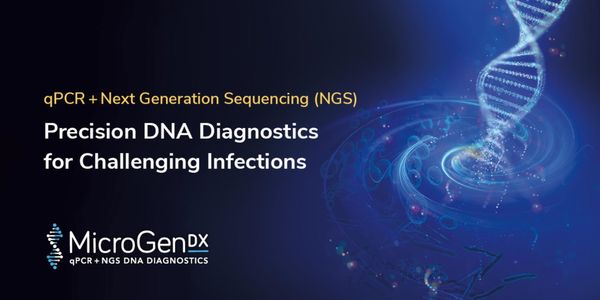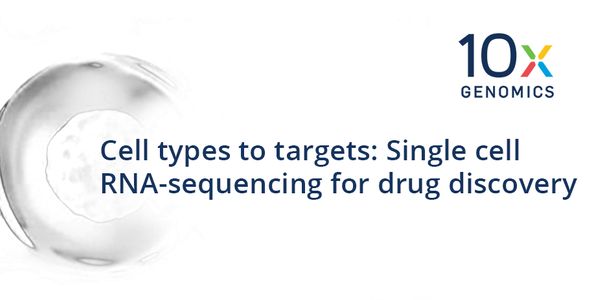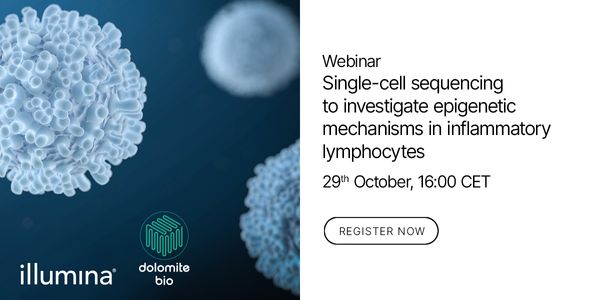Genomics
Genomics: an interdisciplinary field of science within the field of molecular biology. A genome is a complete set of DNA within a single cell of an organism, and as such, focuses on the structure, function, evolution, and mapping of genomes. Genomics aims at the collective characterization and quantification of genes, which direct the production of proteins with the assistance of enzymes and messenger molecules. Genomics also involves the sequencing and analysis of genomes.
-
November 13, 2020 5:00 PM PST | November 14, 2020 9:00 AM SGTEnsuring that clinical tests are not affected by tumor heterogeneity requires a sampling methodology that captures the genomic, proteomic, and cellular diversity of entire solid tumors. Howe...NOV 12, 2020 | 3:00 PMWhat if your lab could perform exome sequencing with the same sensitivity and efficiency of targeted sequencing? The new integrated QIAseq Human Exome TR Insights solution from QIAGEN delive...Speaker: Brian Dugan, M.S. , Rupert Yip, PhDNovember 12, 2020 11:00 AM PST | 6:00 PM GMTVisit the RoundTable Room to participate in live Q&A with all the speakers!...Speaker: Charalambos C. Solomides, MD , Sara Eglitis, MS, QIHC , Faruk Erdem Kombak, MD , Srabani Bhaumik, PhD , Nelson Alexander, PhDPresented at: DISCOVERY Global User Symposium
November 12, 2020 10:00 AM PST | 5:00 PM GMTEnsuring that clinical tests are not affected by tumor heterogeneity requires a sampling methodology that captures the genomic, proteomic, and cellular diversity of entire solid tumors. Howe...NOV 10, 2020 | 7:00 AMDATE: November 10, 2020 TIME: 7:00am PDT, 10:00am EDT Automation can provide tremendous benefits such as increased pipetting precision and accuracy, productivity, and throughput. Numerous wo...NOV 05, 2020 | 7:00 AMDATE: Date needed, 2020 TIME: Time needed Exosomes are a population of naturally occurring mobile, membrane-limited, 30 – 100 nm in diameter, extracellular vesicles containing a large...Speaker: Jorge Escobar , Aurélie TachenyNOV 02, 2020 | 8:00 AMDate: November 2, 2020 Time: 8:00am PST. Rapid and accurate microbial diagnostic information can change treatment courses and outcomes for patients inflicted with infections. The limitation...OCT 29, 2020 | 8:00 AMDate: October 29, 2020 Time: 8:00am (PDT), 11:00am (EDT) What cell types cause and perpetuate disease? For many diseases, scientists only have guesses to this critical question. Single cell...OCT 29, 2020 | 6:00 AMDate: October 29, 2020 Time: 6:00am (PDT), 9:00am (EDT), Chronic inflammation can occur as a result of a combination of genetic predispositions and environmental factors. Epigenetic modifica...Speaker: Thomas Ayers, Ph.D. , Pawel Zajac, Ph.D. , Dr. Adam CribbsSponsored By: Illumina, Dolomite BioOCT 22, 2020 | 1:35 PMPrecision oncology continues to evolve as additional clinically relevant biomarkers are identified. The challenges facing the clinical researchers include not only the ability to add additio...OCT 22, 2020 | 1:35 PMPrecision oncology continues to evolve as additional clinically relevant biomarkers are identified. The challenges facing both diagnostic laboratories and clinicians include not only the abi...OCT 22, 2020 | 1:15 PMTo identify genetic variants in archival human samples, researchers need a powerful NGS platform that can accommodate input DNA and RNA that is often low quality and/or low quantity. This ch...Speaker: Craig Mackinnon, MD, PhDPresented at: OncomineWorld 2022: A Virtual NGS Education Meeting
OCT 22, 2020 | 12:25 PMMyeloid neoplasms represent a highly heterogeneous group of diseases that encompass myeloproliferative, myelodysplastic (myeloproliferative/myelodysplastic) processes and acute myeloid leuke...Speaker: Megan S. Lim, MD, PhDPresented at: OncomineWorld Autumn: A virtual NGS education meeting
OCT 22, 2020 | 12:25 PMMyeloid neoplasms represent a highly heterogeneous group of diseases that encompass myeloproliferative, myelodysplastic (myeloproliferative/myelodysplastic) processes and acute myeloid leuke...OCT 22, 2020 | 7:40 AMIdentification of actionable mutations, determination of tumor mutational burden (TMB) and microsatellite (MS) status are paramount to precision oncology and the Oncomine Comprehensive Assay...OCT 22, 2020 | 7:40 AMIIdentification of relevant mutations, determination of tumor mutational burden (TMB) and microsatellite (MS) status are paramount to precision oncology research and the Oncomine Comprehensi...OCT 21, 2020 | 10:15 PMComprehensive genomic profiling in clinical studies helps to detect clinically relevant cancer driver mutations using low amount of tumor tissues within several days. Recent studies have sho...OCT 21, 2020 | 10:15 PMComprehensive genomic profiling in clinical research studies helps to detect clinically relevant cancer driver mutations using low amount of tumor tissues within several days. Recent studies...OCT 21, 2020 | 9:25 PMHigh grade serous ovarian cancer is characterized by genomic instability, with ~50% of advanced tumors harboring homologous recombination repair (HRR) pathway deficiency (HRD). HRD results i...Speaker: Natalie Ngoi, MBBS, MMed, MRCPPresented at: OncomineWorld Autumn: A virtual NGS education meeting
OCT 21, 2020 | 9:25 PMHigh grade serous ovarian cancer is characterized by genomic instability, with ~50% of advanced tumors harboring homologous recombination repair (HRR) pathway deficiency (HRD). HRD results i...Speaker: Natalie Ngoi, MBBS, MMed, MRCPPresented at: OncomineWorld 2022: A Virtual NGS Education Meeting
OCT 13, 2020 | 2:30 PM...Speaker: Arjun Khanna , David Chi Leung Lam, MD, PhD , Chein-Feng Li, MD , Darren Wan Teck LimOCT 08, 2020 | 6:00 PMWhile circulating cell-free DNA (ccfDNA) and to some extend CTCs from blood are routinely used as analyte in liquid biopsy cancer research applications, circulating cell-free RNA (ccfRNA) ha...Speaker: Thorsten Voss, PhDOCT 08, 2020 | 3:00 PMThe continued rapid expansion of immunotherapies, including both in vivo and ex vivo therapeutics, has driven the development and adoption of novel tools to study, asses and understand these...Speaker: Benjamin Borgo, PhDOCT 08, 2020 | 9:00 AMDate: October 8, 2020 Time: 9:00am (PTD), 12:00pm (EDT), 5:00pm (GMT) Small DNA viruses require both host DNA replication and repair factors for their replication. The host cell replication...
November 13, 2020 5:00 PM PST | November 14, 2020 9:00 AM SGT
Ensuring that clinical tests are not affected by tumor heterogeneity requires a sampling methodology that captures the genomic, proteomic, and cellular diversity of entire solid tumors. Howe...
NOV 12, 2020 | 3:00 PM
What if your lab could perform exome sequencing with the same sensitivity and efficiency of targeted sequencing? The new integrated QIAseq Human Exome TR Insights solution from QIAGEN delive...
Speaker:
Brian Dugan, M.S.
, Rupert Yip, PhD
November 12, 2020 11:00 AM PST | 6:00 PM GMT
Visit the RoundTable Room to participate in live Q&A with all the speakers!...
Speaker:
Charalambos C. Solomides, MD
, Sara Eglitis, MS, QIHC
, Faruk Erdem Kombak, MD
, Srabani Bhaumik, PhD
, Nelson Alexander, PhD
Presented at: DISCOVERY Global User Symposium
November 12, 2020 10:00 AM PST | 5:00 PM GMT
Ensuring that clinical tests are not affected by tumor heterogeneity requires a sampling methodology that captures the genomic, proteomic, and cellular diversity of entire solid tumors. Howe...
NOV 10, 2020 | 7:00 AM
DATE: November 10, 2020 TIME: 7:00am PDT, 10:00am EDT Automation can provide tremendous benefits such as increased pipetting precision and accuracy, productivity, and throughput. Numerous wo...
NOV 05, 2020 | 7:00 AM
DATE: Date needed, 2020 TIME: Time needed Exosomes are a population of naturally occurring mobile, membrane-limited, 30 – 100 nm in diameter, extracellular vesicles containing a large...
Speaker:
Jorge Escobar
, Aurélie Tacheny
NOV 02, 2020 | 8:00 AM
Date: November 2, 2020 Time: 8:00am PST. Rapid and accurate microbial diagnostic information can change treatment courses and outcomes for patients inflicted with infections. The limitation...
OCT 29, 2020 | 8:00 AM
Date: October 29, 2020 Time: 8:00am (PDT), 11:00am (EDT) What cell types cause and perpetuate disease? For many diseases, scientists only have guesses to this critical question. Single cell...
OCT 29, 2020 | 6:00 AM
Date: October 29, 2020 Time: 6:00am (PDT), 9:00am (EDT), Chronic inflammation can occur as a result of a combination of genetic predispositions and environmental factors. Epigenetic modifica...
Speaker:
Thomas Ayers, Ph.D.
, Pawel Zajac, Ph.D.
, Dr. Adam Cribbs
Sponsored By: Illumina,
Dolomite Bio
OCT 22, 2020 | 1:35 PM
Precision oncology continues to evolve as additional clinically relevant biomarkers are identified. The challenges facing the clinical researchers include not only the ability to add additio...
OCT 22, 2020 | 1:35 PM
Precision oncology continues to evolve as additional clinically relevant biomarkers are identified. The challenges facing both diagnostic laboratories and clinicians include not only the abi...
OCT 22, 2020 | 1:15 PM
To identify genetic variants in archival human samples, researchers need a powerful NGS platform that can accommodate input DNA and RNA that is often low quality and/or low quantity. This ch...
Speaker:
Craig Mackinnon, MD, PhD
Presented at: OncomineWorld 2022: A Virtual NGS Education Meeting
OCT 22, 2020 | 12:25 PM
Myeloid neoplasms represent a highly heterogeneous group of diseases that encompass myeloproliferative, myelodysplastic (myeloproliferative/myelodysplastic) processes and acute myeloid leuke...
Speaker:
Megan S. Lim, MD, PhD
Presented at: OncomineWorld Autumn: A virtual NGS education meeting
OCT 22, 2020 | 12:25 PM
Myeloid neoplasms represent a highly heterogeneous group of diseases that encompass myeloproliferative, myelodysplastic (myeloproliferative/myelodysplastic) processes and acute myeloid leuke...
OCT 22, 2020 | 7:40 AM
Identification of actionable mutations, determination of tumor mutational burden (TMB) and microsatellite (MS) status are paramount to precision oncology and the Oncomine Comprehensive Assay...
OCT 22, 2020 | 7:40 AM
IIdentification of relevant mutations, determination of tumor mutational burden (TMB) and microsatellite (MS) status are paramount to precision oncology research and the Oncomine Comprehensi...
OCT 21, 2020 | 10:15 PM
Comprehensive genomic profiling in clinical studies helps to detect clinically relevant cancer driver mutations using low amount of tumor tissues within several days. Recent studies have sho...
OCT 21, 2020 | 10:15 PM
Comprehensive genomic profiling in clinical research studies helps to detect clinically relevant cancer driver mutations using low amount of tumor tissues within several days. Recent studies...
OCT 21, 2020 | 9:25 PM
High grade serous ovarian cancer is characterized by genomic instability, with ~50% of advanced tumors harboring homologous recombination repair (HRR) pathway deficiency (HRD). HRD results i...
Speaker:
Natalie Ngoi, MBBS, MMed, MRCP
Presented at: OncomineWorld Autumn: A virtual NGS education meeting
OCT 21, 2020 | 9:25 PM
High grade serous ovarian cancer is characterized by genomic instability, with ~50% of advanced tumors harboring homologous recombination repair (HRR) pathway deficiency (HRD). HRD results i...
Speaker:
Natalie Ngoi, MBBS, MMed, MRCP
Presented at: OncomineWorld 2022: A Virtual NGS Education Meeting
OCT 13, 2020 | 2:30 PM
...
Speaker:
Arjun Khanna
, David Chi Leung Lam, MD, PhD
, Chein-Feng Li, MD
, Darren Wan Teck Lim
OCT 08, 2020 | 6:00 PM
While circulating cell-free DNA (ccfDNA) and to some extend CTCs from blood are routinely used as analyte in liquid biopsy cancer research applications, circulating cell-free RNA (ccfRNA) ha...
Speaker:
Thorsten Voss, PhD
OCT 08, 2020 | 3:00 PM
The continued rapid expansion of immunotherapies, including both in vivo and ex vivo therapeutics, has driven the development and adoption of novel tools to study, asses and understand these...
Speaker:
Benjamin Borgo, PhD
OCT 08, 2020 | 9:00 AM
Date: October 8, 2020 Time: 9:00am (PTD), 12:00pm (EDT), 5:00pm (GMT) Small DNA viruses require both host DNA replication and repair factors for their replication. The host cell replication...


















